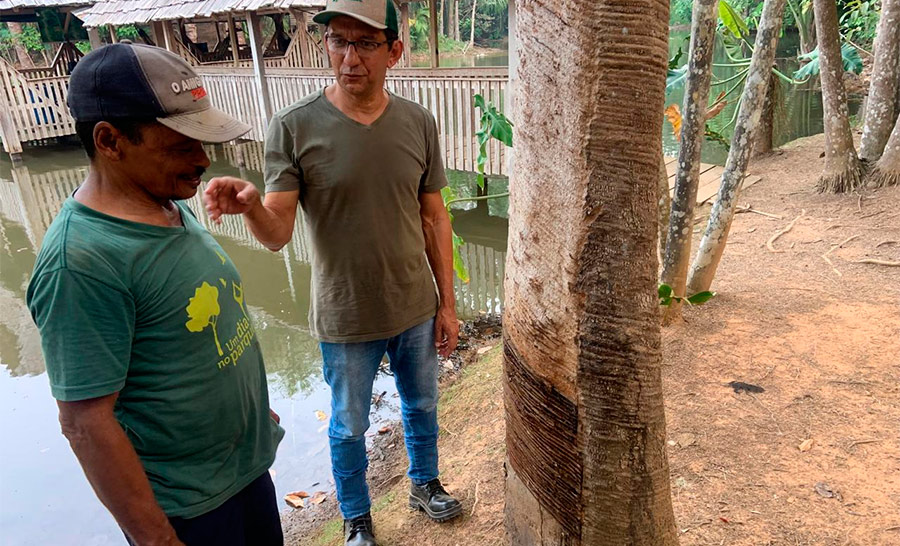


An extractivist speaks with Professor Raimundo Maciel of Ufac in front of a rubber tree during a visit by researchers to the Chico Mendes Extractive Reserve in September 2024 (photo: GT Socioeconomia)
Published on 06/30/2025
By André Julião | Agência FAPESP – Consumers pay around BRL 100 per kilogram for Brazil nuts at retail outlets in São Paulo, Brazil’s largest metropolis located in the Southeast region of the country. This price might lead one to believe that collecting nuts is a lucrative business. However, in Acre, a state in the North region and one where the plant is native, extractors sell a kilogram of raw nuts for around BRL 4.50 – almost 22 times less than consumers pay in the Southeast.
The price contrasts with that of another Amazonian product, which has achieved sustainable social, environmental, and economic value in the Chico Mendes Extractive Reserve (RESEX), as a study by researchers from the Federal University of Acre (UFAC), the State University of Campinas (UNICAMP), and the Ministry of Agrarian Development and Family Agriculture (MDAF) points out.
“The price paid per kilo of native rubber in the RESEX, BRL 24, is almost eight times higher than the market price, thanks to an agreement with a company that buys the entire production and pays for the socio-environmental service provided by the extractors, keeping the forest standing,” says Lucas Ferreira Lima, a collaborating researcher at the Institute of Economics (IE) at UNICAMP and one of the co-authors of the study.
“In return, the 11-kilogram can of nuts is sold at a price 2.8 times lower than ideal, taking into account the same economic and socio-environmental criteria considered in calculating the price of rubber,” he adds.
The work is part of a project supported by FAPESP in conjunction with the research support foundations of the states of Pará (FAPESPA) and Acre (FAPAC). This project is part of the Amazon+10 Initiative.
“The price paid for Brazil nuts is not enough to enable what we call the social reproduction of these populations, which is to remain in the area with dignity, conserving the forest and avoiding migration to urban areas,” explains Ademar Romeiro, a professor at IE-UNICAMP and project coordinator.
Productivity and income
In a previous study, the researchers assessed the environmental and socioeconomic sustainability of the Chico Mendes RESEX.
Using the Multicriteria Decision Analysis (MCDA) method, which included interviews and conferences, the researchers developed the Multicriteria Sustainability Index (MSI). The analysis classifies the RESEX as sustainable to varying degrees in the five dimensions evaluated: governance, agronomic, environmental, economic, and social.
The social and economic indicators received the most attention because they are close to a moderately sustainable scale. For this reason, the researchers are exploring alternatives for families, such as the socio-environmental valuation of Brazil nuts and rubber, as well as the use of Agroforestry Systems (AFSs).
In the latter case, fruits, vegetables, and forest products such as mahogany and Brazil nuts can be cultivated while maintaining the integrity of the forest. This practice has proven to be more profitable than extensive cattle ranching. The researchers will now evaluate the sustainability of this practice and its potential as an alternative to beef cattle in the region.
“The productivity and income obtained from cattle raising are low in the RESEX. Basically, calves are sold to be fattened in the neighboring state of Rondônia. Cattle are seen as a store of value, a savings account, something that can be sold quickly to raise money for emergencies,” explains Lima.
The Chico Mendes RESEX was created in March 1990, just over a year after the assassination of the rubber tapper leader after whom the reserve was named. The federal sustainable use conservation unit covers an area of just over 970,000 hectares distributed between Xapuri and six other municipalities in Acre. Currently, about 2,000 families reside in the reserve.
The creation of the reserve ensures land ownership for traditional populations and protects ecosystem resources and services by strengthening traditional extractive activities and generating adequate income.
For the past 28 years, a research project led by the Center for Applied Legal and Social Sciences (CCJSA) at UFAC has monitored the families. The Socioeconomic Analysis of Rural Family Production in the State of Acre (ASPF) project is coordinated by Raimundo Cláudio Gomes Maciel, a professor at the institution and the lead author of the scale study.
On an experimental scale since 2006 and on a large scale since 2018, all native rubber production from the RESEX has been sold to Veja. Veja uses the product purchased from extractivists to make the soles of its sneakers. The French company entered the Brazilian market in 2014 under the Vert brand. However, in 2024, it began operating under the same name used in its other 100+ markets.
In addition to the market price of approximately BRL 3 per kilogram, rubber tappers receive municipal, state, and federal subsidies, as well as BRL 10.50 from the company for Payment for Socio-Environmental Services (PSSA). The UFAC group first made the calculation in 2019 and updated it in 2023.
“There’s no point in trying to keep people in the territory and the forest standing without incentives. The market price alone doesn’t guarantee a decent life for people. Payment for socio-environmental services is something that’s proven to be interesting, but a consistent public policy is needed to ensure nature conservation and people’s dignity,” concludes Romeiro.
The study “Valuation and payment for socio-environmental services in the Chico Mendes Extractive Reserve” is available as a PDF at www.eco.unicamp.br/images/arquivos/artigos/TD/TD464_2.pdf.
The article “Multicriteria Sustainability Index (MSI) in the Chico Mendes Extractive Reserve, Acre, Brazil” is available in the same format at www.eco.unicamp.br/images/arquivos/artigos/TD/TD457.pdf.
Source: https://agencia.fapesp.br/55213